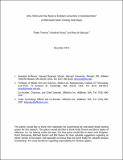| dc.contributor.author | Teixeira, Thales | |
| dc.contributor.author | el Kaliouby, Rana | |
| dc.contributor.author | Picard, Rosalind W. | |
| dc.date.accessioned | 2017-03-24T20:29:26Z | |
| dc.date.available | 2017-03-24T20:29:26Z | |
| dc.date.issued | 2014-05 | |
| dc.date.submitted | 2013-01 | |
| dc.identifier.issn | 0732-2399 | |
| dc.identifier.issn | 1526-548X | |
| dc.identifier.uri | http://hdl.handle.net/1721.1/107701 | |
| dc.description.abstract | The presence of positive entertainment (e.g., visual imagery, upbeat music, humor) in TV advertisements can make them more attractive and persuasive. However, little is known about the downside of too much entertainment. This research focuses on why, when, and how much to entertain consumers in TV advertisements. We collected data in a large scale field study using 82 ads with various levels of entertainment shown to 178 consumers in their homes and workplaces. Using a novel web-based face tracking system, we continuously measure consumers' smile responses, viewing interest, and purchase intent. A simultaneous Bayesian hierarchical model is estimated to assess how different levels of entertainment affect purchases by endogenizing viewing interest. We find that entertainment has an inverted U-shape relationship to purchase intent. Importantly, we separate entertainment into that which comes before the brand versus that which comes after, and find that the latter is positively associated with purchase intent while the former is not. | en_US |
| dc.language.iso | en_US | |
| dc.publisher | Institute for Operations Research and the Management Sciences (INFORMS) | en_US |
| dc.relation.isversionof | http://dx.doi.org/10.1287/mksc.2014.0854 | en_US |
| dc.rights | Creative Commons Attribution-Noncommercial-Share Alike | en_US |
| dc.rights.uri | http://creativecommons.org/licenses/by-nc-sa/4.0/ | en_US |
| dc.source | MIT web domain | en_US |
| dc.title | Why, When, and How Much to Entertain Consumers in Advertisements? A Web-Based Facial Tracking Field Study | en_US |
| dc.type | Article | en_US |
| dc.identifier.citation | Teixeira, Thales, Rosalind Picard, and Rana el Kaliouby. “Why, When, and How Much to Entertain Consumers in Advertisements? A Web-Based Facial Tracking Field Study.” Marketing Science 33, no. 6 (November 2014): 809–827. | en_US |
| dc.contributor.department | Massachusetts Institute of Technology. Media Laboratory | en_US |
| dc.contributor.department | Program in Media Arts and Sciences (Massachusetts Institute of Technology) | en_US |
| dc.contributor.mitauthor | Picard, Rosalind W. | |
| dc.relation.journal | Marketing Science | en_US |
| dc.eprint.version | Author's final manuscript | en_US |
| dc.type.uri | http://purl.org/eprint/type/JournalArticle | en_US |
| eprint.status | http://purl.org/eprint/status/PeerReviewed | en_US |
| dspace.orderedauthors | Teixeira, Thales; Picard, Rosalind; el Kaliouby, Rana | en_US |
| dspace.embargo.terms | N | en_US |
| dc.identifier.orcid | https://orcid.org/0000-0002-5661-0022 | |
| mit.license | OPEN_ACCESS_POLICY | en_US |
